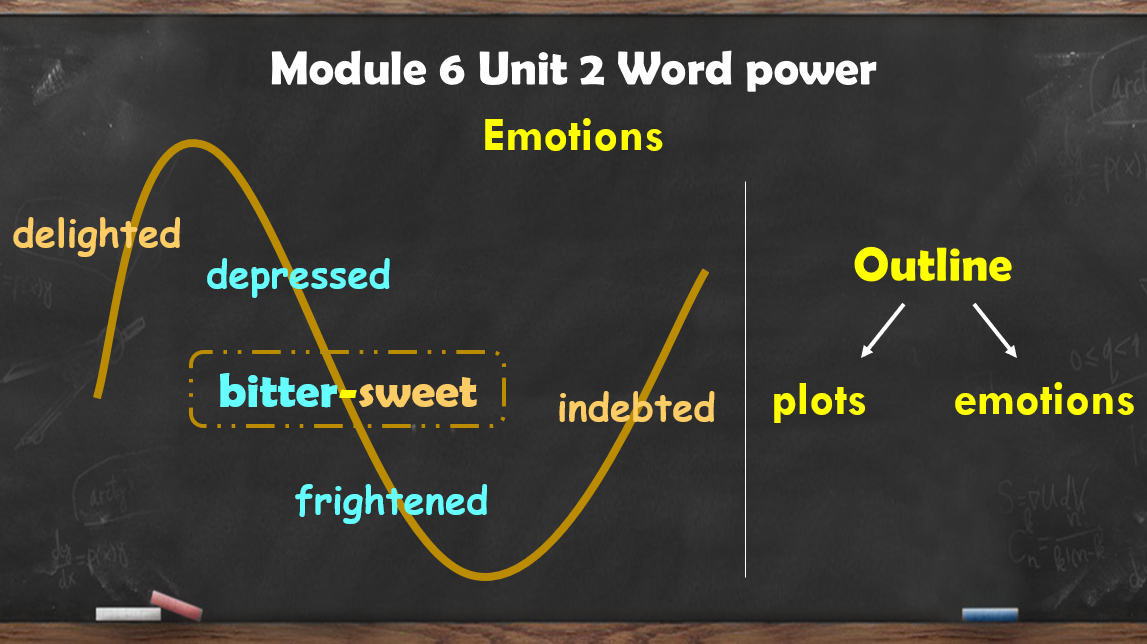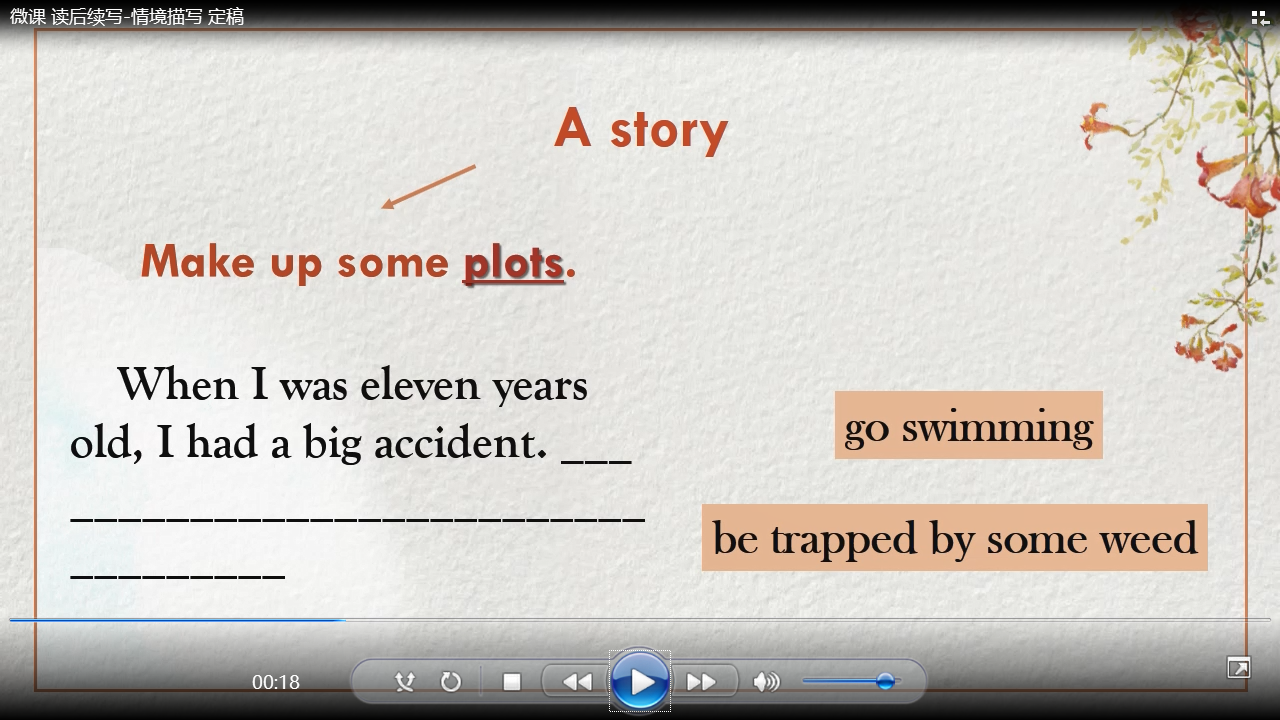- 时间点:
- 时 分 秒 当前视频时间点
- 问题:
-
- 选项一
设为正确答案
新增选项 - 选项一
- 正确跳转时间:
- 时 分 秒 同锚点时间
- 错误跳转时间:
- 时 分 秒 同锚点时间



恭喜你,回答正确~
很遗憾,回答错误~
正确答案: ,您可以



牛津译林高中英语教材《牛津高中英语》是由译林出版社2003年出版,2005年在国内投入使用。教材在内容的选择上体现了思想性、时代性、真实性和多样性的特点,各个单元的题材涉及社会的方方面面,文化内涵丰富;语言真实、自然,情节生动、逼真,并充分考虑学生的实际英语水平,控制语言难度,保持语言的梯度;活动和任务设计灵活、多样、富有情景,重视学习策略,以学生为中心,把学生放在学习主人的位置。《牛津高中英语》由五本必修和六本选修组成,必修模块一到五,每一本书包含三个单元,每个单元包含七个部分:Welcome to the unit, Reading, Word power, Grammar and Usage, Project and Self-assessment。
Word power从两个方面帮助学生学习新的单词,力求快速、高效地扩大他们的词汇量。一是通过介绍英语单词的构词方法(合成、派生、转化等),帮助学生对所学过的单词进行归纳,从中发现规律,同时,根据这些规则向他们介绍更多的符合这些规则的生词;二是根据本单元的有关话题,从Word family的角度,向学生介绍该话题的更多生词。
本课所选为模块六二单元的Word power板块,话题是情绪emotion,单元主题语境是人与自我。教材提供了一些描述情绪的基础单词,教师应当在此基础上进行补充。同时,教材提供了两个练习,一个是关于名词和形容词的辨析,二是短文填空,用描述情绪的单词补全文段,但这两道题的难度对于高二的学生而言是很低的,教师应当在此基础上做出取舍和调整。同时教材里还有一些可以描述情绪的短语可供学生积累。
新高考试卷中加入了读后续写这一题型,涉及到人物描写,那么学会描述人物情绪,并与动作描写相结合,可以为学生的写作加分。所以如何在使用旧有教材的基础上,推陈出新,与新高考题型相结合,是本节课的难点,也会是亮点。
1. 知识与能力分析:
① 本节课内容对应的是高二年级学生,学生已经很好的适应了高中阶段的英语学习,英语基础较好,已掌握一定的与情绪相关的单词,并已很好的理解和掌握了名词和形容词的区别和基本用法。但同时学生掌握的描述情绪的单词相对较为基础和简单,需要更多的扩充。
② 大部分学生都很活跃,能很容易地表达自己地想法,其中一些人富有想象力和创造力,渴望表达自己。这一特点在读后续写的做题过程中也有很好的体现。
③ 但在把描写情绪的单词能合理有效的应用在读后续写中,并能与动作描写相结合进行情境描写,合理续写情节这方面有很大不足,需要更详细的指导和练习。
2. 情感分析:
① 学生的学习兴趣是很浓厚的,有希望改善读后续写答题情况的这种迫切的心情。
② 随着高中阶段学习内容难度的不断加深,面对同龄人压力,学生心里也会出现一定的波动,在如何调节情绪,适应考试节奏,与他人更好的相处等方面,需要教师加强引导和帮助。
3. 个体差异:
①也有部分孩子的基础较为薄弱,单词词汇量不是很好,需要教师在备课过程中够兼顾,并加强指导。
1. 知识与技能
① 通过本课,学生能在已有词汇量的基础上,在具体情境中掌握常见的,同时又更为复杂的描述情绪的单词及其用法,如:bitter-sweet, thrilled, depressed, frustrated, frightened, fearful, indebted等。
② 通过本课,学生能理解并基本掌握,在读后续写中要进行情境描写,把动作描写和心理描写相结合。
2. 过程与方法
① 通过本课,学生要在教师以自己的亲身经历讲授和微课示例的基础上,理解并基本掌握在读后续写中进行情境描写,即把动作描写和心理描写相结合。
② 通过本课,学生要基于团队合作,完成最后的产出活动,可以从动作情节和情绪两方面画出大纲,并作简单的口头陈述。
3. 情感态度和价值观
① 通过本课,引导学生日常生活要保持积极的情绪,并能正确的表达自己的情感和调节自己的负面情绪。
② 通过本课,培养学生有更好的团队合作精神和积极探索问题的精神。
1. 教学重点
① 通过本课,学生能在已有词汇量的基础上,在具体情境中掌握常见的,同时又更为复杂的描述情绪的单词及其用法,如:bitter-sweet, thrilled, depressed, frustrated, frightened, fearful, indebted等。
② 通过本课,学生要在教师以自己的亲身经历讲授和微课示例的基础上,理解并基本掌握在读后续写中进行情境描写的方法,即把动作描写和心理描写相结合。
③ 通过本课,学生要基于团队合作,完成最后的产出活动,可以从动作情节和情绪两方面画出大纲,并作简单的口头陈述。
2. 教学难点
① 通过本课,学生要基于团队合作,完成最后的产出活动,可以从动作情节和情绪两方面画出大纲,并作简单的口头陈述。

1. Time: 1min30s
2. 设计说明:
通过询问学生的当下的心情并请学生猜测教师的情绪,开门见山,点出本节课的主题是情绪,并激活学生的旧有知识(已学过的可描述情绪的基础单词)。
同时,也更贴合学生的生活实际,能较好的激发学生的兴趣,调动学生的积极性。
3. Teaching procedures & Teacher's instructions:
T: Class begins. Good afternoon, my class!
Ss: ...
T: Sit down, please. Two weeks ago, you took part in the sports meeting, what was your feeling at that time?
Ss: Exciting. ...
T: Then, how about your examination?
Ss: ...
T: Well, don't be upset. You are outstanding students. Be confident! As for me, could you guess my feeling these days?
Ss: ...
T: Of course, I'm happy now because I'm so glad to see you. But I'm also a little bit nervous. Do you know the reason?
Ss: ...
T: In fact, because I'm preparing for a teaching competition. More exactly, I feel bitter-sweet. So happy, excited, sad, upset, nervous, bitter-sweet and so on, what are they? what can they describe?
Ss: Emotion!
T: Great, we'll talk about some words related to emotions today. Next, I will share with you something happened to me recently, please use some words to describe my emotions. Follow me!
1. Time: 3min
2. 设计说明:
教师以自己最近准备备课比赛时所经历的事情和情绪为例,为学生补充更多描述情绪的单词。
同时以自身为例,贴近生活,能更为直观的让学生理解何为情境描写,即动作描写(情节)和情绪描写相结合。
3. Materials:
① When I first heard about the teaching competition. I felt delighted/thrilled because I knew I wanted to have a try.
② I spent many hours preparing it. However, when I practiced, my colleagues pointed out many stupid mistakes, which made me very depressed/frustrated.
③ What's worse, something that made me more frightened/fearful happened. I couldn’t find some of my important document.
④ Fortunately, when I was filled with sadness, my roommate tried to find many useful materials for me and inspired me. I’m so grateful/indebted for her kindness.



![]()

4. Teaching procedures & Teacher's instructions:
Period 1:
T:In the beginning, when I first heard about the teaching competition, what was my feeling?
Ss: ...
T: Great! Happy, excited, cheerful, delighted and so on.
Period 2:
T: But then, when I practiced, my colleagues pointed out many stupid mistakes, which made me very?
Ss: ...
T: Good job! Nervous, embarrassed, ..., your answer is perfect!
Period 3:
T: What's worse, I couldn’t find some of my important document. I may be very?
Ss: ...
Period 4:
T: Fortunately, when I was filled with sadness, my roommate tried to find many useful materials for me and inspired me. What was my emotion at that time?
Ss: ...
Period 5:
T: You have provided so many words. That makes me happy again. Please follow me, read the words together.
T: Then, let me show you the outline of my recent experience. As you can see, when I shared my experience, I also used some words to describe my emotions. So using some words related to emotions can help you express exactly and vividly, especially in your continuation writing.
 (此为课件上用动画展示的内容)
(此为课件上用动画展示的内容)
1. Time: 2min30s
2. 设计说明:
以一个真实的读后续写题的第一段续写为例,指导学生如何进行读后续写里的情境化描写,即把动作描写和心理(情绪)描写相结合,为后面的产出活动做重要铺垫。
3. Materials:(此为微课视频内容)
![]()



4. Teaching procedures & Teacher's instructions:
T: Please watch a micro-lesson carefully to know more about it.
......
T: All right, let's do a conclusion. When we make up the main plots of a story, we can also think about the emotions of the main characters, so that our writing can be content-rich and vivid.
1. Time: 7min
2. 设计说明:
通过前面的单词积累,和两次情境描写的示例,需要通过学生之间的合作,让他们亲身体会这一方法,并检验他们的学习效果。
同时,以小组合作的形式促进学生之间的团队合作。
最终学生的产出成果会通过希沃投屏来展示。
3. Material:
Please work in groups, predict what happened and then make an outline of your prediction.
When I was young, I was always willing to try almost anything I was interested in. ___________________________________________________
__________________________________________________________________________________________________
After that accident, I don't think I will go skating with Tim anymore. ___________________________________________________________________
__________________________________________________________________________________________________
4. Teaching procedures & Teacher's instructions:
Period 1:
T: Now, it's your turn to practice. Here is a short text. Please work in groups to predict what happened. You'll have 3 minutes and pay attention; you just need to make an outline. Show the main plots and emotions.
Period 2:
T: Time is up. Which group want to be the first one to show your story?
Ss: ...
T: You're so creative! Thank you! One more group?
Ss: ...
T: Which story do you prefer?
Ss: ...
T: I think all of them can be transformed into attractive stories. After class, please polish your outline and write a complete story. I'm looking forward to them.
1. Time: 30s
2. 设计说明:
请学生简单总结本节课所讲重点内容,并进行情感升华,通过鼓励学生,相信他们下一次会取得更好成绩,来引导学生要学会调节情绪,成为情绪的主人,也能与课堂导入相衔接,形成呼应。
3. Instruction:
T: In the end, let's do a short summary about what we learned today. Any volunteer?
Ss: ...
T: Thank you for your good presentation. By now, I have completed the last step of my teaching competition. I suffered a lot but also learned a lot. So please try to be the master of your emotions, and you will find happiness in your daily life. I'm sure all of you will achieve high grades next time. Trust yourself!
1. Time: 15s
2. 设计说明:课上时间有限,完整的故事续写只能留给学生课后进行,同时也是通过作业巩固学生本课所学。
3. Instruction:
T: So much for this. Today's homework, please polish your outline and write a complete story. Class is over, thank you for you good performance! See you next time!
设为正确答案